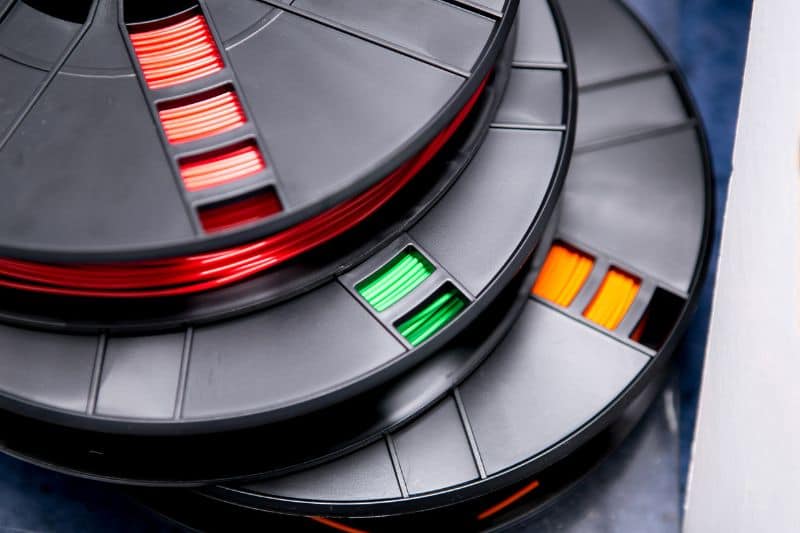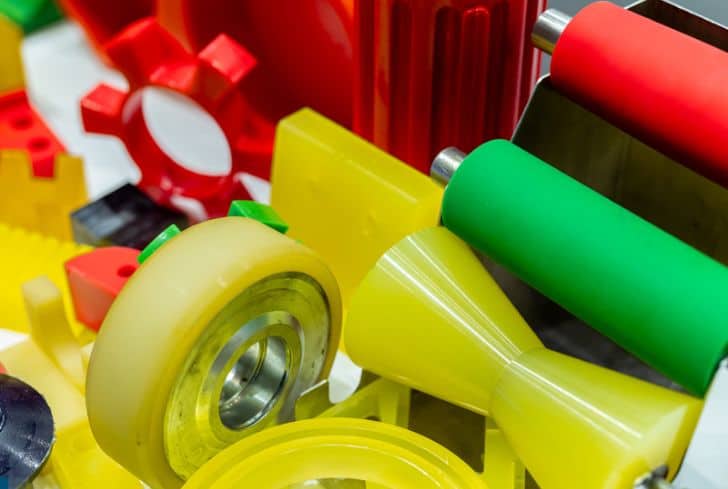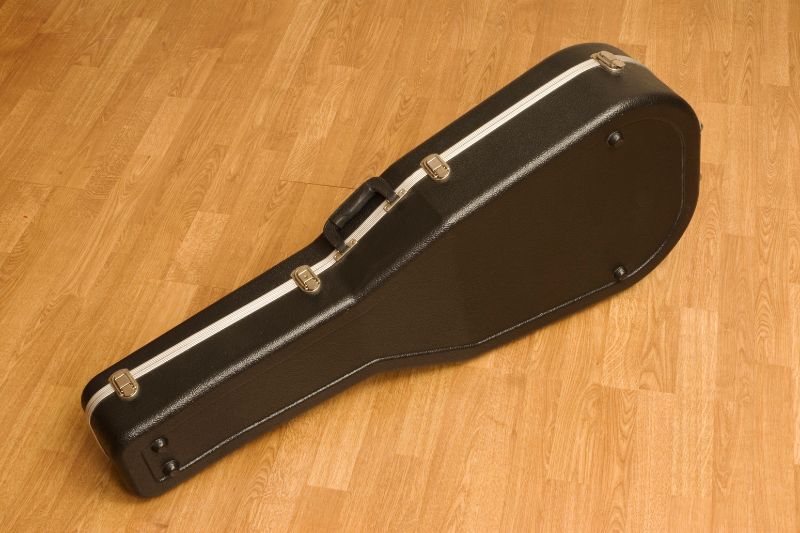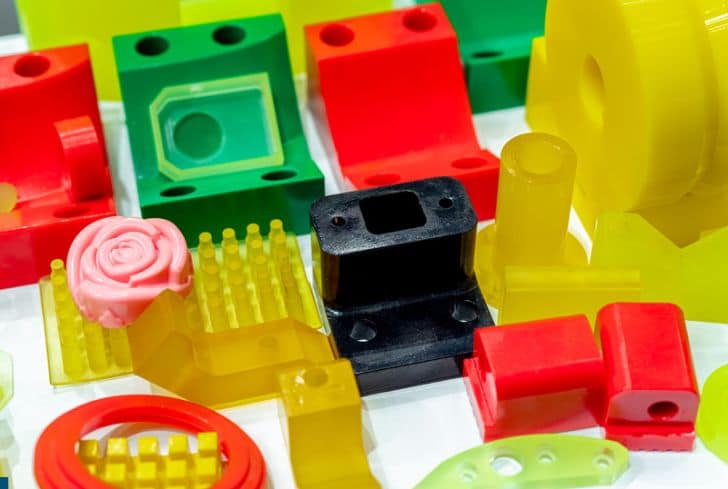During World War II, the need for dependable, protective clothing sparked the growth of thermoplastic polymers. The concept of ABS plastic was first developed by the Borg-Warner firm in 1948, but it took another 6 years for it to be made commercially available.
Today, more than 6000 ABS plastic grades are available with applications other than cell phones. Let us explore everything there is to know about ABS plastic and whether it can be recycled.
What is ABS Plastic?
ABS stands for acrylonitrile butadiene styrene. ABS is a polymer plastic made from petroleum that may be modified at various temperatures. When heated, thermoplastic polymers like ABS may turn flexible or rubbery.
They can harden once again after cooling. Since ABS falls under the category of an amorphous compound, it deviates from the other ordered materials’ inherent phase trend.
In other words, unlike most materials, ABS plastic does not change from a solid to a fluid at a certain temperature. Due to this, it lacks a true melting point. Its glass transition temperature is 105°C instead.
And when we talk about glass transition temperature, it’s simply the temperature at which an amorphous substance changes from a stiff to a rubber-like state. ABS is known as a terpolymer since it comprises three separate polymers.
A substance known as a polymer is one that is constructed from repeating, sizable molecules. The chemical processes known as polymerization are used to join the chains. As you may infer from its full name, the three polymers that makeup ABS are acrylonitrile, styrene, and polybutadiene.
The molecular makeup of ABS is made up of a lengthy polybutadiene chain. The styrene and acrylonitrile smaller chains are connected to the large chain in a crisscross pattern.
The features of ABS as a whole are influenced by its particular molecular structure and the characteristics of individual polymers. ABS is known as a terpolymer since it comprises three separate polymers.
What is ABS Used For?
ABS has an endless number of uses. The casing for power tools, the plastic face-guard on wall outlets, computer keyboard keys, and LEGO toys are some of the most commonly recognized uses of ABS. Below are some uses of ABS.
1. Gardening Tools
ABS is frequently used to make gardening equipment since it is affordable and strong. ABS is frequently used to create miniature claws, shovels, hoes, rakes, and other hand tools, making them affordable and lightweight.

2. Pipes and Fittings
Since ABS is affordable, it is used for pipelines and fittings in residential and business environments. It will not peel, flake, rot, leak, dissolve, or fade unless penetrated.
ABS is the best material for external applications, underground, in extremely cold environments, and in locations away from direct sunlight. Systems for drain, vent, and waste piping frequently use ABS piping.
3. Medical Applications
Despite not being used for medical implants, ABS has numerous other uses in the medical field. ABS resins are used because of their outstanding purity, minimal remaining monomers, consistency from lot to lot, and outstanding whiteness.
Nebulizers, medication distribution systems, compressors, and housings for medical equipment can all be made of ABS plastic.
4. 3D Building Material
Among the most widely utilized materials for 3D construction is ABS. Although it is more heat-sensitive than PLA, it still has the strength, production capabilities, and range of colors required for additive manufacturing procedures.
5. Automotive Industry
The automotive sector frequently substitutes ABS for metal. ABS thermoplastic is used in various automobile parts that aim to be lighter. Handles, door closers, pillar trim, meter panels, seat backs, dashboard components, and seat belt components are some items that frequently use ABS.
6. Vacuum Construction
Vacuum cleaners also utilize ABS. Nowadays, ABS plastic still makes up the majority of upright and canister vacuum casings; polycarbonates, steel, and other significant impact polymers are only used when extra strength is required.
ABS plastic works well for big vacuum case layouts and housings with a durable, affordable, and lightweight material.
7. Musical Instruments
Numerous musical instruments, including recorders, tambourines, plastic clarinets, harmonicas, bugles, percussion instruments, and flutes, to name a few, are produced using ABS plastic.
8. Machine Prototype Construction
Prototyping frequently uses ABS plastic. It is utilized in several forms of fast prototyping, including injection molding and 3D printing; thanks to how simple it is to use and how inexpensive it is to produce, this plastic is widely used.

Can You Recycle ABS Plastic?
Sheets, bath trays, automobile components, skeletal debris, and ABS pipes are all recyclable forms of ABS plastic. ABS plastic is recyclable; as pure ABS can be pricey to utilize in manufacturing, recycled ABS is growing in popularity.
ABS, or Acrylonitrile-Butadiene-Styrene, possesses remarkable strength and durability due to its distinctive properties. Not only is it recyclable, but the process is also straightforward and can be completed at home with the right tools.
Opting to recycle surplus ABS is the environmentally friendly alternative. The recycling procedure remains consistent, whether carried out at home, in a municipal recycling center, or an industrial facility.
When it comes to ABS filament at home, recycling stands out as the preferred option over casting. ABS has been assigned the recycling code 7 by Los Angeles for recycling purposes.
Recycling Process of ABS Plastic
There are several ways to recycle ABS plastic. It may be disassembled, melted into pellets, and used again to make new goods. Alternatively, it can be shredded and used to make items like flowerpots or patio furniture.
Below is the recycling process for ABS plastic.
1. Segregation
Before purifying, ABS must be isolated from other polymers, trash, and impurities.
At the manufacturing level, froth flotation is used to separate the materials. The technique uses impure ABS and an oil-water mixture to distinguish plastic from other particles.
The segregation of municipal and residential waste will occur at the collecting stage, and a container will be used to transport the ABS plastic.
2. Grinding
Once the segregation has been done, the resulting ABS parts will next be ground up into granules. At this point, a commercial grinder or a home grinder comes in handy.
3. Melting and Reforming
To melt and reconstruct the ABS plastic, the granules are fed into an extruder. Based on the extruder’s task, you can anticipate receiving recycled ABS plastic as plastic threads or sheets.
ABS plastic granules may also be added to an appropriate injection molding machine to melt and create new goods. However, the issue is that most recycling plants cannot recycle ABS plastics.
You see, due to their extremely stiff structure, these plastics require greater temperatures to melt them. Hence, accepting ABS plastic with such demands presents a hurdle for most plastic recycling plants.
Additionally, they assert that the finished product will be of poor quality. Moreover, the ecosystem is harmed because of the landfills where these plastics end up.

Is ABS Plastic Biodegradable?
Unfortunately, ABS plastic cannot be decomposed by microbes like fungi and bacteria, which makes it a non-biodegradable material. Due to some recycling factories’ refusal to accept them, most of them wound up in landfills.
The idea that “biodegradable plastic” may be recycled while facilities do not accept it is a prevalent misunderstanding.
They assert that the finished compost will be of low quality or inferiority. Additionally, items marked as biodegradable plastic take a very long time to break down organically in the environment.
Because ABS is the toughest plastic available, this is the case. The material comprises three polymers, which add to its remarkable stiffness. It implies that the structural makeup of ABS cannot be disturbed by anything else at high temperatures.
This kind of plastic is not renewable because not even decomposers can organically break it down. The Ecological Engineering magazine claims that ABS plastic could slightly degrade. However, that could take as long as 500 years or longer.
Biodegradable plastics could take a very long time to break down naturally in the environment.
Is ABS a Toxic Material?
Thankfully, ABS plastic is regarded as non-toxic when it is in its finished form, such as appliances or toys. It is stable, non-leaching, and it has not yet been linked to cancer.
However, its application in the food sector and for internal medical devices has yet to be subject to regulation. The problem is that ABS turns poisonous after going through various manufacturing steps.
In addition, ABS material can catch fire when subjected to extremely high temperatures, releasing hazardous gases like hydrogen cyanide and carbon monoxide.
It’s important to highlight that ABS plastic carries risks during any “melting process” as the terpolymer breaks down into individual polymers like acrylonitrile and styrene. This risk extends to the application of solvents on components from 3D-printed patterns for smoothing purposes.
Moreover, ABS plastic poses environmental hazards. A significant concern is the release of ABS dust and tiny particles into the atmosphere during 3D printing, a known health risk. These particles can irritate the skin, eyes, and lungs.
Finally, exposure to UV light results in the degradation of ABS, potentially leading to the leaching of certain chemicals.
Conclusion
ABS plastic is considered “recyclable” because it may be heated and used once more. However, it has various drawbacks in addition to its beneficial traits. Scratches and degradation of ABS plastic are common.
Additionally, ABS plastic may crack when using grease or oils as lubricants. Manufacturers have created polycarbonate-ABS plastic alloys for improvement. ABS gains additional strength, rigidity, and heat resistance thanks to polycarbonate.






